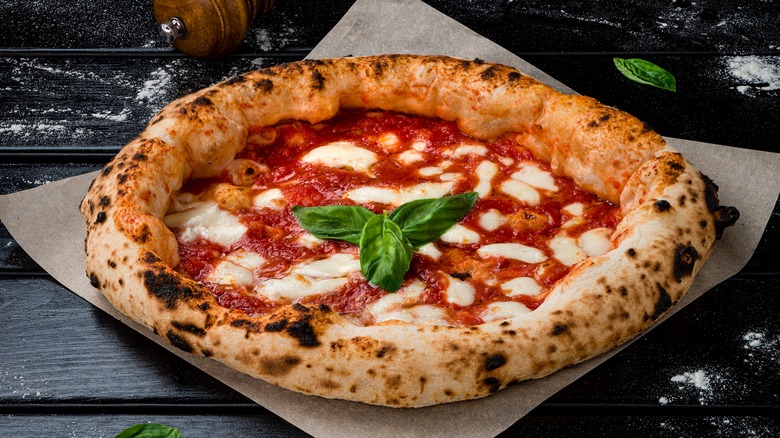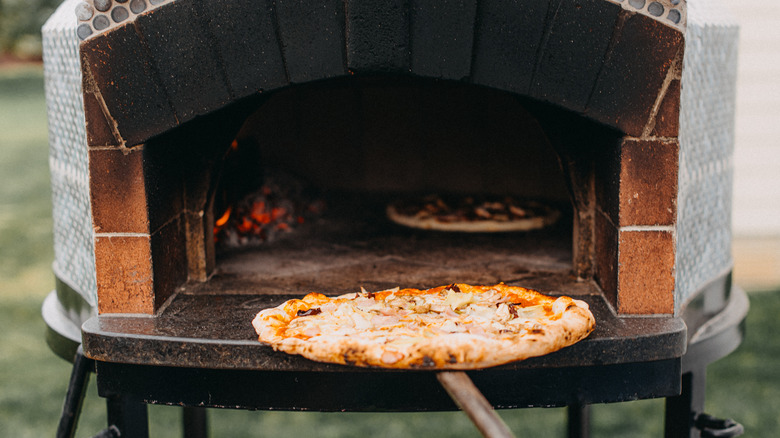Indoor Vs. Outdoor Pizza Ovens: Is One Better Than The Other?
If you've ever wondered how much someone cares about certain foods, take a glance at their array of kitchen appliances. A toaster and a microwave may not be too unusual, but an ice cream maker is a good clue that someone takes their sweet treats very seriously. Another example of such a cooking tool is the pizza oven. A pizza cooker in a person's home is a sure sign they have a deep love for all things 'za.
Pizza ovens provide a lot of benefits, like allowing you to cook multiple pizzas very quickly. More importantly, cooking pizza in one of these ovens gives it terrific texture, and will ensure you never have soggy dough again. As appealing as pizza ovens are, they're still an investment. Even at the cheaper end, a reliable one can cost over $150. But if you're a pizza purist who's ready to take the plunge, it'll be worth it, especially if you find a pizza oven that suits your specific needs. From small portable options to ovens that require a whole crew to install, there are many different types of pizza ovens out there, but we can easily divide them into two categories: indoor and outdoor ovens. Which type is best for you will depend on your space, your budget, and how much work you want to stand between you and your delicious pie.
Indoor ovens are smaller and cheaper
One of the main differences between the two types of pizza ovens is that indoor ovens will typically run off of electricity, though some that can be used indoors use gas. The benefit of an electric oven is that it's very easy to use since you don't have to deal with stoking a fire or providing propane. You should still keep an eye on the pizza while it's cooking, but it will be a lot less work (giving you more time for pizza experimentation, like using yogurt to make dough). Another pro of an indoor oven is that you can use it at any time without having to battle the elements. Plus, they are also usually cheaper! That said, it's worth noting that pizzas made in an electric oven will unfortunately lack that wood-fired taste that comes from a wood-fired oven.
When in the market for an indoor pizza oven, first measure out what kind of counter space you're working with. Indoor ovens are certainly smaller than their outdoor counterparts, but many are still the size of a small microwave, so make sure you have someplace to store it when it's not in use. In terms of performance, look for one that can reach temperatures of at least 700 degrees Fahrenheit so the pizza will cook fast enough to get a char.
Outdoor ovens are great for company
Whether you opt for an adaptable freestanding appliance or a beautifully crafted traditional brick oven, these monuments to pizza will definitely serve as a centerpiece and gathering area in any backyard. Outdoor ovens typically either run off of wood or gas, which each have their own pros and cons. Basically, gas is easier to use since you can set it and forget it (metaphorically. Don't let your pizza burn!) Wood, on the other hand, will infuse your pizza with a delicious smoky taste, but you'll have to constantly monitor it to make sure it doesn't get too hot or burn out.
That smoky flavor is why most folks invest in an outdoor pizza oven. Another huge draw is the idea of using your outdoor oven to entertain and cook for all your friends. Unlike indoor ovens, which usually can only hold one pizza at a time, some outdoor ovens can fit up to four pies. And while "pizza" is in the name, you can use outdoor ovens to give a wood-fired roast to all sorts of food, like bread, veggies, or even a whole roast chicken. That said, outdoor ovens are ultimately more expensive and often have a bit of a learning curve when it comes to perfecting your pies, so many people may prefer sacrificing a little flavor and authenticity for the ease of an indoor oven. No matter which way you go, you'll be making some next-level pizza.


